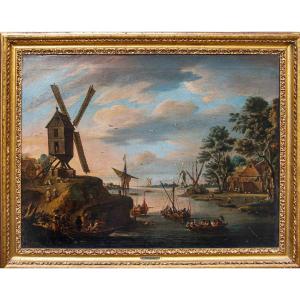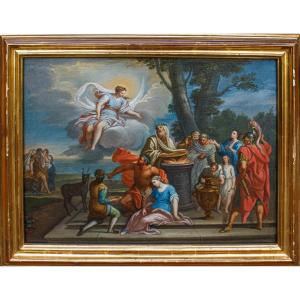Adoration of the Shepherds
Oil on canvas, cm 90.5 x 126
The work under consideration, an oil on canvas depicting an Adoration of the Shepherds, can be referred to for stylistic and iconographic qualities at the hand of a seventeenth century Venetian artist, probably gravitating around the figure of Antonio Vassilacchi (1557 - 1629), considered one of the most important and innovative painters of the Mannerist period.
Despite the sources recounting his birth in the Greek island of Milos, the recent discovery of a document in the State Archives in Venice, in which the painter himself testifies to his birth in Venice, indicates that he was born and raised in the Castello sestiere. His parents, because of his strong artistic tendencies, sent him to the workshop at sixteen years from Veronese, where he soon became his pupil and collaborated with him for a series of frescoes in the bishop’s palace of Treviso, then in the church of Sant'Agata in Padua, in Montecchia di Crosara and in various churches in Venice. He had his great opportunity when a fire in December 1577 destroyed the Doge’s Palace in Venice, and he was one of the painters commissioned to perform frescoes in the reconstructed building: his works in the Ducal Palace, probably surpass those of any other single artist, as he painted in all the main halls of the Palace, such as the Hall of the Great Council, the Hall of Scrutineering, the Senate Room, the Hall of the Council of Ten and the Compass Room.
In 1584 he became a member of the Fraglia of the Venetian painters, and it was there that he was given the nickname of Aliense, from the Latin alienus, foreigner, because he was neither Venetian nor Italian.I lavori di Vassilacchi si caratterizzano per un’estrema originalità, fantasia e virtuosismo tecnico. Maestro di colore, composizione e scorcio, i suoi dipinti sono ricchi di movimento ed emozione, dimostrando di aver pienamente appreso la lezione dei Bassano: si vedano l’uso calcolato della luce, attraverso la quale l’artista ricrea un senso di profondità e atmosfera; l’importanza data al paesaggio, mai semplice fondale ma parte integrante della composizione; l’attenzione mostrata per la vita quotidiana e per le persone umili, rese con umanità e realismo. L’opera risente anche delle influenze del Veronese, per ciò che concerne le cromie, soprattutto i blu molto intensi e i rosi illuminati di biacca.
L'opera di Vassilacchi fu molto influente a suo tempo, continuando oggi ad essere ammirata dagli amanti dell'arte di oggi. La tela mostra un vero e proprio corteo di personaggi tra pastori, paesani e angeli radunati intorno alla Sacra Famiglia; al di sopra l’artista raffigura quattro putti alati emergere da una nube dorata recanti un cartiglio recitante “GLORIA IN EXCELSIS DEO ET INTERREPAX”, prima parte dell'inno cristiano, che in italiano significa "Gloria a Dio nell'alto dei cieli", cantato tradizionalmente durante la Messa cattolica.
L'oggetto è in buono stato di conservazione
















































 Le Magazine de PROANTIC
Le Magazine de PROANTIC TRÉSORS Magazine
TRÉSORS Magazine Rivista Artiquariato
Rivista Artiquariato